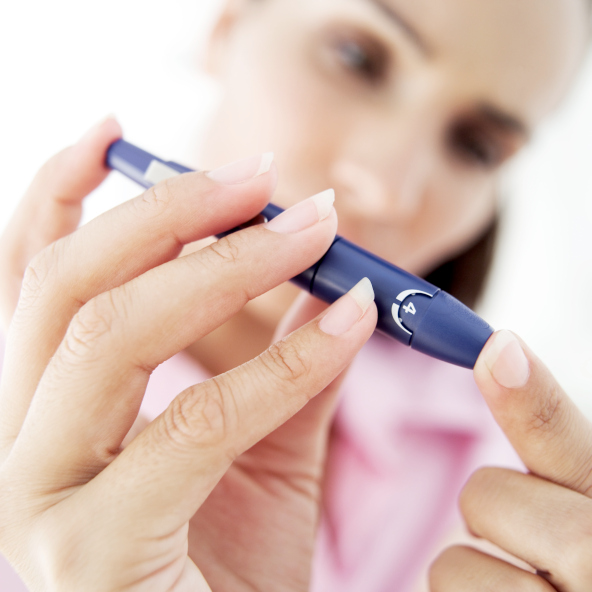Diabetes Complications
 If you’ve been living with diabetes for some time now, you probably know what it feels like when your blood glucose drops too low. Sudden sweating and chills, shakiness, and weakness are ways your body tells you that you need sugar right now. You’ve learned that when you feel that way you need to take glucose tablets or drink some juice. If you don’t, your blood glucose can keep dropping and you might pass out.
If you’ve been living with diabetes for some time now, you probably know what it feels like when your blood glucose drops too low. Sudden sweating and chills, shakiness, and weakness are ways your body tells you that you need sugar right now. You’ve learned that when you feel that way you need to take glucose tablets or drink some juice. If you don’t, your blood glucose can keep dropping and you might pass out.
Diabetes can affect your entire body; over many years, it can lead to complications. High blood glucose levels can damage your eyes, the nerves in your feet and legs, and your blood vessels. Keeping your blood glucose as close to normal as possible can lower your risk for complications. Getting regular check-ups can help you find complications early, when they can be treated.
Although it is scary to think about complications, knowing the symptoms means you can talk with your healthcare provider as soon as you notice them. Keep notes for your provider about when you first had the symptom, or if anything made it better or worse. After all, no one knows your body better than you do.
Your Eyes
 The retina is in the back of your eye, and works like the film in an old camera. It allows light from the outside world to form a picture that is sent to your brain. Your retina has many tiny, fragile blood vessels. High blood glucose causes the blood vessel walls to get weaker. As a result, blood can leak into the back of the eye and make it harder for you to see.
The retina is in the back of your eye, and works like the film in an old camera. It allows light from the outside world to form a picture that is sent to your brain. Your retina has many tiny, fragile blood vessels. High blood glucose causes the blood vessel walls to get weaker. As a result, blood can leak into the back of the eye and make it harder for you to see.
Because damage to your eyes from diabetes is not always noticeable, it is recommended that people with diabetes have their eyes dilated and checked once a year. If your healthcare provider finds damage to the blood vessels, they can treat it. Finding the damage early can lower your chances of losing your vision. It is also important to call your eye doctor right away if you notice any changes in your vision.
Your Feet and Legs
 High blood glucose levels can cause damage to your nerves. This is known as “neuropathy.” Damage to your nerves can cause you to be either more or less sensitive. You may feel pain or have areas where you feel nothing at all. It can also make it harder for you to feel heat or cold. Neuropathy tends to happen most often in the feet or the legs. This is because these nerves are the longest in the body and the farthest from your spine.
High blood glucose levels can cause damage to your nerves. This is known as “neuropathy.” Damage to your nerves can cause you to be either more or less sensitive. You may feel pain or have areas where you feel nothing at all. It can also make it harder for you to feel heat or cold. Neuropathy tends to happen most often in the feet or the legs. This is because these nerves are the longest in the body and the farthest from your spine.
You can imagine that when you have neuropathy, it is hard to know if your bathwater is too hot or if you have a rock in your shoe. You can end up with burns or blisters that take a long time to heal, or that become infected. If you feel tingling or a pins and needles in your feet, more or less feelings of pain, or any unusual numbness or weakness, ask your healthcare provider about how you can prevent more damage to your feet and legs. Because diabetes affects blood flow, sores or infections can take longer to heal. Preventing problems is always a better option than treating them.
Speaking of blood flow, another problem that can affect your feet and legs is called “peripheral arterial disease,” or PAD. PAD happens when the blood vessels become narrow or blocked, and less blood flows to your feet and legs. PAD is more common among people with diabetes, but you are especially at risk if you smoke. If you needed another reason to quit smoking, let this be it.
The symptoms of PAD are similar to those of neuropathy. Numbness, tingling, or feeling cold in your legs and feet are symptoms of PAD. Your skin may look more pale than normal, or even turn blue. You may feel shooting leg pains, especially when you walk or exercise. You may not be able to walk very far without pain. PAD is not just your muscles telling you that you’re tired. Reduced blood flow is serious. Talk to your healthcare provider about these symptoms so you can get the treatment you need.
Your Heart and Blood Vessels
 Diabetes can damage the blood vessels that flow to your heart and brain. People with diabetes are twice as likely to die of heart disease as people without diabetes. The good news is that you can lower your risk by meeting the following targets:
Diabetes can damage the blood vessels that flow to your heart and brain. People with diabetes are twice as likely to die of heart disease as people without diabetes. The good news is that you can lower your risk by meeting the following targets:
- Blood pressure less than 140/80 mmHg.
- Total cholesterol of 200 mg/dL or less, or LDL cholesterol of less than100 mg/dL and HDL cholesterol or 45 – 55 mg/dL or higher. Triglycerides of 150 mg/dL or lower.
- Having a body mass index (BMI) of 30 or less.
- Getting 30 minutes of exercise, 3 – 5 times a week.
- Not smoking.
How Can I Prevent Complications?
Although you need to be aware of diabetes complications, there is good news. Most of the complications are linked with high blood glucose levels over time. You can do a lot to lower your risk by keeping your blood glucose levels as close to normal as is safe for you. There are new and better treatments than ever before and more research is being done every day. Yes, it is hard to hear about the complications. But being aware of the symptoms helps you get the treatment you need in time. And, this way, you can keep them from becoming worse. The more you know, the more you can do to have a longer and healthier future.












